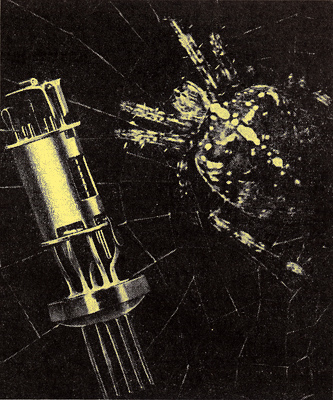|

An RF pentode with characteristics similar to those of the well-known American 6AK5 has been added to the Mullard range of miniatures. Known as the EF95 the new pentode is of all-glass construction with a B7G base. Its low noise qualities and low input and output capacitances render it particularly suitable for use in VHF equipments. Other features of interest are: low heater consumption, e.g., 175 mA at 6.3 V, optimum performance obtainable with only 180 V HT and quite good results with 120 V.

Sub-miniature tuning indicator, DM70
Another new Mullard valve is a novel tuning indicator said to be the first of its kind that can be used in all-dry battery receivers as well as in mains sets. Of sub-miniature construction, it has no base and is intended to be wired into the set. The DM70, as it is known, is a triode and has a plate-type control grid with an aperture shaped like an exclamation mark and through which the anode is viewed. The anode is coated with fluorescent material and the illumination produced is controlled by the negative potential on the control grid.
The indicator operates normally at 90 V HT and consumes 0.24 mA, but it will also function at 60 V if necessary. With 90 V HT the grid extinction voltage is -11 and with 60 V it is -9.5 V. The filament is directly heated and requires 1.4 V at 25 mA.

'Come into my parlour' said the spider to the valve, mistaking it for a fly. We do not know whether spiders have bad eyesight or not, but at any rate this electrode structure or a sub-miniature hearing-aid valve is not very much bigger than a blue-bottle, and the spider (common garden type) can hardly be blamed for investigating it.
The valve is a typical example of the products of a new experimental factory set up by Mullard at Whyteleafe, Surrey, specially for the mass production of miniature, sub-miniature and 'reliable' valves.
|